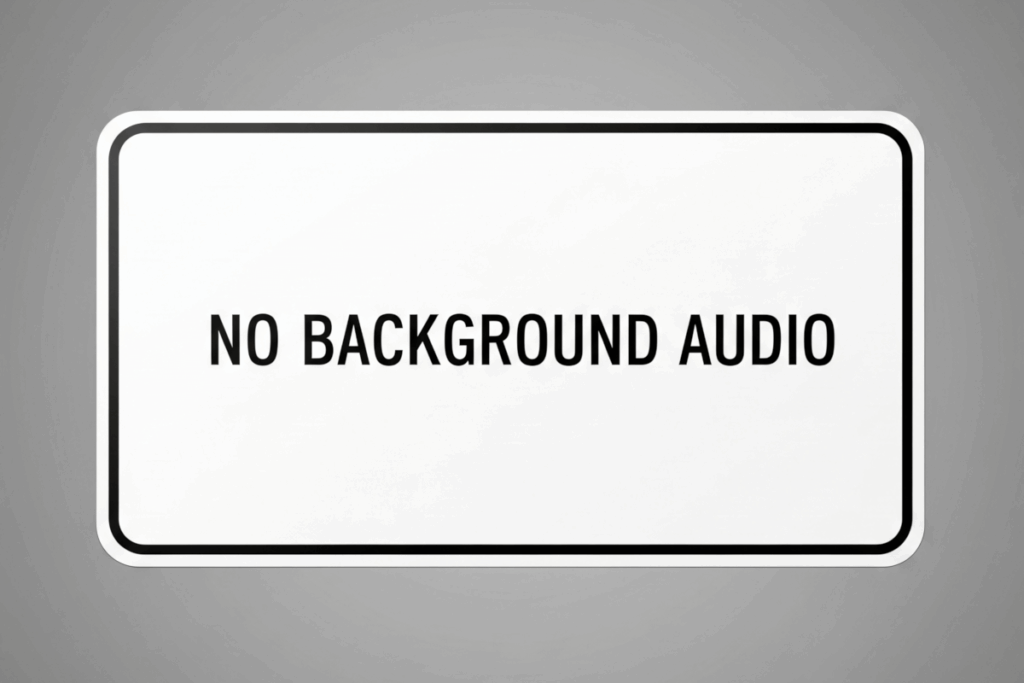Note: The creation of this article on testing Low or No Background Audio was human-based, with the assistance on artificial intelligence.
Explanation of the success criteria
WCAG 1.4.7 Low or No Background Audio is a Level AAA conformance level Success Criterion. It states that audio content (like speech or dialogue) must not have background sounds that make the speech hard to hear. There are a few exceptions to this:
- The background sounds can be turned off.
- The background sounds are at least 20 decibels quieter than the speech.
- The background sounds are essential to the content (e.g., a dramatic scene where music and dialogue are both critical).
People who use hearing aids often struggle to separate speech from background noise. Reducing or eliminating background audio makes spoken content much more accessible.
Note that this Success Criterion is at a conformance level of AAA. This means that this Success Criterion is generally considered aspirational, going beyond the standard A & AA conformance levels. It addresses more specific accessibility needs and is not mandatory for all websites or content. However, achieving Level AAA can provide additional benefits in terms of inclusivity.
Who does this benefit?
- People who are hard of hearing often have great difficulty separating speech from background sound.
- Screen reader users who are focused on screen reader announcements, yet have a background sound or music interfering with those announcements.
Testing via Automated testing
Automated testing can quickly scan for the presence of audio files, check if audio controls (like volume sliders or mute buttons) are available, and flag media that autoplays without user control, potential indicators of problematic background audio.
However, automated tools can’t “hear” the content like a human can. They can’t distinguish speech from background noise, assess volume differences, or determine whether background sounds are essential to the experience.
Testing via Artificial Intelligence (AI)
AI-based testing can analyze audio tracks to detect overlapping speech and background sounds, estimate relative volume levels, and even flag instances where background noise may overpower dialogue. This can significantly speed up the review process, especially for large volumes of multimedia content.
However, AI-based testing still struggles with context and nuance. It may not reliably determine whether background audio is essential to the content or if it meaningfully interferes with comprehension. AI also can’t always evaluate subjective audio clarity the way a human with hearing loss might experience it.
Testing via Manual testing
Manual testing has clear advantages. Human testers can accurately judge whether background sounds interfere with speech clarity, something that requires subjective listening and context awareness. They can also determine whether background audio is essential to the content or if it could reasonably be removed or reduced.
However, manual testing can be time-consuming, especially when reviewing lengthy multimedia content. It also requires careful listening in a controlled environment and may vary depending on the tester’s hearing ability or equipment. But when it comes to nuanced audio judgments, there’s still no substitute for the human ear.
Which approach is best?
No single approach for testing 1.4.7 Low or No Background Audio is perfect. However, using the strengths of each approach in combination can have a positive effect.
Testing is best approached through a combination of methods, though manual testing remains the most reliable. Automated tools have limited capability here, they may detect the presence of audio tracks but cannot determine whether background sounds interfere with speech. AI-based testing offers potential by analyzing audio waveforms to estimate relative volumes, but they still struggle to account for contextual factors, like whether the background audio is essential or if the speech remains intelligible. Manual testing is crucial for evaluating the clarity of spoken content, judging the necessity of background sounds, and determining if users can disable or reduce them. The most effective strategy is to use automation or AI to flag media for review, then rely on human testers to assess compliance based on actual listening.
